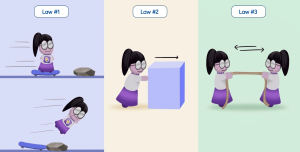Introduction: Free-body diagrams and friction
The basis of what we cover in 1A03 has been understood for hundreds of years. These fundamental laws of physics, while not new, are still highly relevant and applicable. Through the discovery of new and exciting daily applications, we further our understanding of the world around us. While this particular lab focuses on the groundbreaking work of Sir Isaac Newton, it’s important to acknowledge that our current understanding of physics is a result of the combined efforts of large diverse groups of scientists. By performing these labs, you are gearing up to contribute to the vast data and understanding of our universe, and you are training to become scientists (fight imposter syndrome!). A big part of the understanding process has been developing tools like mathematical notation and free-body diagrams. In this lab you will use these tools to understand the forces in your experiments.

Newton’s Laws, in its original publication. By using free-body diagrams and some mathematical notation, you will be able to explain the second law much more clearly.

Here are three scenarios representing Newton’s three laws. Law #1 states that an object at rest stays at rest and an object in motion stays in motion, unless acted upon by an external force. Law #2 tells us that the force exerted on an object is proportional to its mass and acceleration (F = ma). Law #3 states that every action has a reaction that is equal in magnitude and opposite in direction.
In Exercise 1, you will use free-body diagrams to predict the results of the upcoming experiments. By using the free-body diagram as a tool, you will see how the forces in Exercises 1-4 should balance. Additionally, you will develop equations of motion that you will test in the following exercises.
In Exercise 2, you will measure the force of static friction between your shoe and an inclined smooth surface. By measuring the angle of the inclined surface where the shoe just begins to slip, you will be able to quantify the coefficient of static friction between your shoe and the flat surface (i.e. measure the mu of a shoe).
In Exercise 3, you will measure another friction coefficient, but this time you will be looking at kinetic friction. Similar to Exercise 2, you will put your shoe on an inclined surface. In this exercise, the shoe will accelerate down the ramp, and you can determine this acceleration by taking two measurements: the length of the ramp and the time it takes to slide down the ramp. Once you know the acceleration of your shoe, you can calculate the coefficient of kinetic friction.
In Exercise 4, you will interpret and draw a graph of the frictional force as a function of the applied force. This will lead into a final discussion question in Exercise 5 that will test your understanding of all these concepts.
Learning Objectives
Set yourself the following learning outcomes for this lab:
By the end of this lab, I will
- Analyze physical situations, and draw representative free-body diagrams for both stationary and in-motion scenarios.
- Develop equations that describe both the force of static friction and kinetic friction.
- Apply the concepts of friction to real-life scenarios that exemplify acceleration, static forces, and dynamic forces.
- Identify static versus kinetic frictional forces and how they affect motion.
But before any of that, it’s important to get warmed up!
